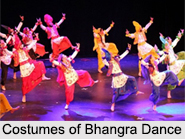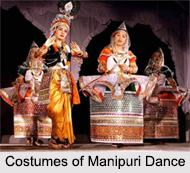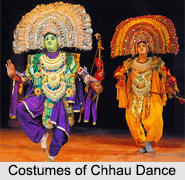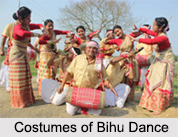 Costumes in Indian folk dances are colourful with all-embracing jewels and designs. Indian folk and tribal dances are performed with the simple motive of expressing joy. Folk and tribal dances are performed during every possible occasion, to celebrate the birth of a child, the arrival of seasons, a wedding and various festivals.
Costumes in Indian folk dances are colourful with all-embracing jewels and designs. Indian folk and tribal dances are performed with the simple motive of expressing joy. Folk and tribal dances are performed during every possible occasion, to celebrate the birth of a child, the arrival of seasons, a wedding and various festivals.
The dancing costumes in Indian folk dances are usually of uncomplicated pieces, so that free movement of limbs is possible. In eastern India, tribal women wear saree, while the men wear turbans and dhotis. Similarly, during a north Indian folk dance, the women usually wear Salwar Kameez with a glistening dupatta and the men wear churidars with turban. In western India, the costumes in folk dances are similar to the traditional attire of Rajasthan and Gujarat; similarly, in South Indian folk dances, the costumes perfectly blend with the traditional dresses of the state. However, in some cases exceptions usage of masks and other decorative components like leaves, barks of trees, bones are also seen. Indian folk dances are simple with some typical movement and steps. The costumes of these dances reflect the spirit of the performance and vitality. Men and women perform some dances exclusively, while in some performances men and women dance together. In such performances, the costumes are made to look alike, either in pattern or in colours combinations. On most occasions, the dancers sing themselves, while being accompanied by artists on the instruments. Each form of dance has a detailed costume. Most costumes of Indian folk dances are colourful.
Costumes of Indian popular Folk dances are as follows:
Bhangra is one of most popular folk dances, originating from Punjab. The costume of a Bhangra dancer comprises a bright, coloured Patka on the head, a lacha or lungi of the same colour, a long tunic and a black or blue waistcoat and ghunghroos on the ankles. However, some dancers also wear small rings (nuntian) in their ears. The costume of another north Indian folk dance, Jhumar is a simple loose shirt. Yet another folk dance of Himachal Pradesh, Namagen is performed by both men and women and the costumes worn by the dancers are usually made of wool and are richly studded. The women wear ample pieces of silver jewellery. Dumhal of Kashmir is a folk dance performed by the men folk of the Wattal tribe, who wear long colourful robes, tall conical caps that are studded with beads and shells. The costumes of north Indian folk dances, thus, resemble the native dressing style of men and women.
The conventional attire of the female Gujarati dancers have been Kurta also known as Zabho and Pajamas called Lehengas. Gujarati attires are bright in style and brilliantly coloured. The traditional attire of Gujarati men dancers are Dhoti, Long and Short coat as well as turban cap.
The Kalbeliya dancers are women in curving black skirts who dance and spin, replicating the movements of a serpent. The upper body cloth is called Angrakhi and a piece of cloth worn on head known as Odhni, also the lower body cloth is called Lehenga. All these cloths are mixed in red and black hues and embroidered in such a way that when these dancers perform these clothes represent a mixture of colours soothing to eyes as well as to the ambience. 
The costumes of Manipuri Dance are very charming. The women wear a tight-fitting pointed cap of black velvet or other material, trimmed with a border of synthetic pearls, under a thin white covering. Modern dancers often discard the cap in favour of a bun on top and to the side of the head, and haloed with flowers. The choli or tight fitting bodice is regularly of velvet with tight sleeves trimmed with gold stitching. The ghagra or flounced skirt is of a striking colour, yellow, red or green and usually of silk with a wide border at the base of the skirt consisting of a design of sequins. Tiny square, round or oval mirrors are scattered all over the skirt, which has a transparent Muslim garment over it, embroidered with silver thread. As the dancers swirl round, the flashing mirrors reflecting the light produce a striking effect. The male dancer wears a dhoti with embroidered bands across his chest ending in flaps that fall over both hips. In the Ras-Leela, Krishna is gorgeously attired in a pleated dhoti of gold or yellow silk, the chest being covered with glittering necklaces while wristlets and armlets adorn the arms.
Bihu performers wear simple pieces of clothes which can let the free movement of limbs and hands. The draping styles of these costumes are typically very simple and uncomplicated but the clothes used for this purpose are actually striking with matching jewellery and other ornaments. The male members of the troop wear a dhoti, which is generally made of cotton. The dhoti is worn in traditional drapes to cover the lower portion of the body. The gamocha is used as a head band or sometimes tied in the waist to give a more vibrant and colourful look to the attire.
The women performers of Bihu wear a traditional lower body garment known as Mekhala, while a chaddar is used to cover the greater portion of the body. Besides the mekhala and chaddar, women also wear jewellery and put flowers in their plaits to celebrate the spirit of spring.
Lavani Dance is performed by Dhangars or shepherds of Sholapur district of Maharashtra. The poetry is written by Dhangras gets its inspiration by nature. The costume includes Dhoti, Angrakha, Pheta and a colourful handkerchief.
Chhau Dance is a well-liked form of tribal dance in India that includes elements of martial arts into its groups. The male dancers wear brightly coloured dhotis with a matching kurta on top. The kurta is usually obscured by the vast amount of costume jewellery that is worn in the form of necklaces. These are large in size, not just in number, and extremely heavy. Female dancers, or male dancers depicting female characters, are known to wear colourful sarees. The masks worn during this presentation are of very important significance as they are used to express emotions and the nature of the character, much like the way Grecian Masks functioned in plays.
 Padayani is a spectacular folk dance form of south India, originating in Kerala. The elaborate costume of this dance bears slight resemblance to Theyyam. The performers are always men who also enact female roles wearing necessary make-up and costumes. The costumes generally consist of palm leaves, cloth and brass jewellery, wild masks and a big headgear that extends up to 40 ft in height. The size and appearance of the costume astonishes the audience. With its unique and grotesque make-up and costume, this folk art is a magnetic attraction in the south.
Padayani is a spectacular folk dance form of south India, originating in Kerala. The elaborate costume of this dance bears slight resemblance to Theyyam. The performers are always men who also enact female roles wearing necessary make-up and costumes. The costumes generally consist of palm leaves, cloth and brass jewellery, wild masks and a big headgear that extends up to 40 ft in height. The size and appearance of the costume astonishes the audience. With its unique and grotesque make-up and costume, this folk art is a magnetic attraction in the south.
Dollu Kunitha or Dollu Dance, a famous folk dance of Karnataka is mainly performed with quick and light movement of the feet and legs. The costumes of the performers are simple. Upper part of the body is usually left bare while the black sheet-rug is tied on the lower part of the body over the `dhoti` or sarong. Virbhadra is a folk dance of Goa. The person enacting the role of Virbhadra dresses himself in a warrior`s costumes. He wields swords as he dances his way in the grounds of the temples. Mando-Dhulpod, also a folk dance of Goa features peculiar costume of the performers. The notable feature is its pattern resembling the Burmese Saronge-type dress, locally called Tollopo.
Dalkhai is the most popular folk-dance of Odisha, performed on occasions like Phangun Puni, Bhai juntia, Nuakhai and so on. The women usually dress themselves with the colourful Sambalpuri Sari and wear a scarf on the shoulders holding the ends below in both the hands. Adorned with traditional ornaments and flowers their full-bodied frames sustain the lively steps for long hours.
The Veeranatyam dancers are well-known for their multi-coloured dresses and cheerful cries, which light up the whole atmosphere and fill it with greatest devotion to Lord Shiva. Their worship becomes all the more passionate with the lively steps and the lively attires, which are cautiously chosen for the occasion. For the dance, the performers wear the Dattis and Dhotis, which are in various hues and extremely colourful. The dresses are totally in sync with the overall atmosphere of devotion, dedication, oneness and reverence of Lord Shiva.
Dandiya, a famous folk dance of Rajasthan is probably the most spectacular sight owing to its unique costume. Women wear dazzling coloured Chaniya Cholis and men wear Kedias. Chaniya Cholis are hand embroidered and embellished with mirrors, shells and anything that matches with it. Women wear jewellery that is an assortment of traditional Gujarat and modern-day fashion. Along with such dress, they wear Mojdee, they are handmade pure leather shoes with embroidery on the superior surface with hardened leather soles.
The colourful costumes of Indian folk dances enhance the beauty of the performance. Folk dances are the particular style of dancing that originated from the ordinary people of a society or region, thus their costumes are also native and closely associated with the customs of the originating state. Indian folk dances also reflect the diversity in Indian tradition and culture, thus the costumes also differ according to the tribe and place of birth.



















